#Santa María Magdalena and Palomo Monument
Photo

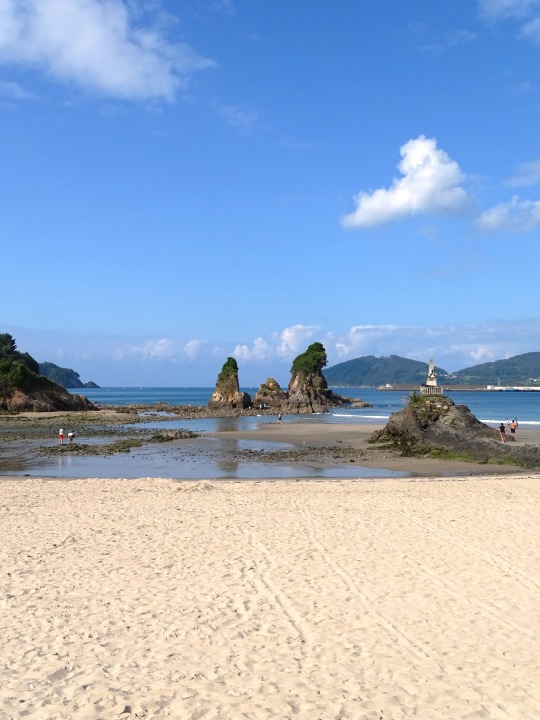

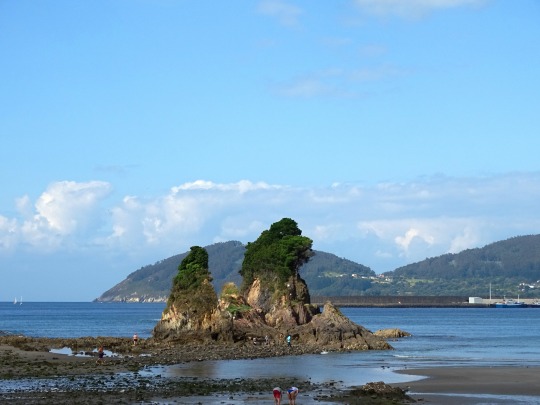
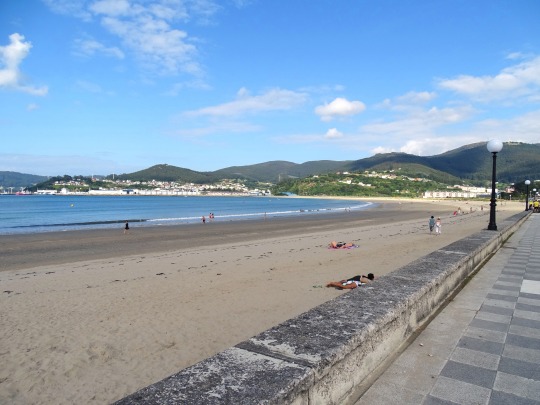

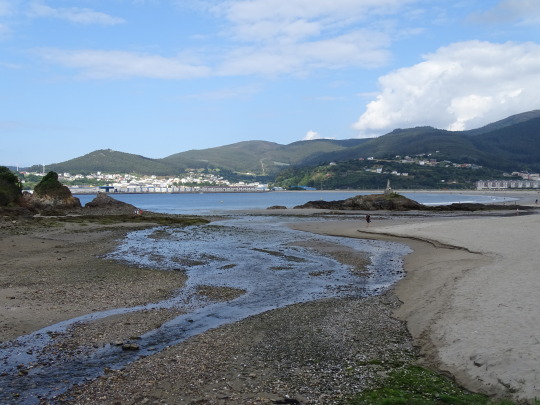
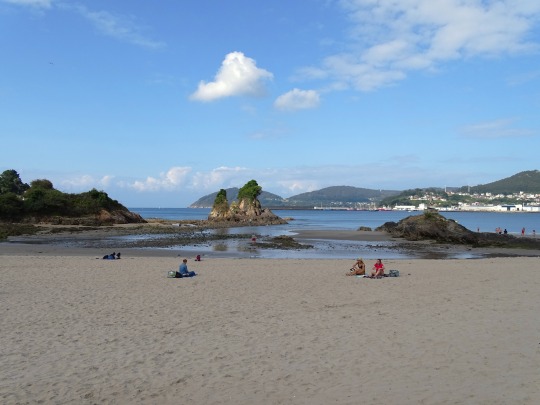

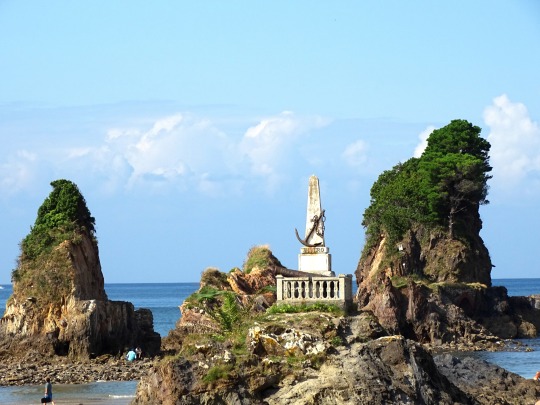
Covas Beach, Viveiro (No. 12)
Galicia has a surface area of 29,574 square kilometres (11,419 sq mi). Its northernmost point, at 43°47′N, is Estaca de Bares (also the northernmost point of Spain); its southernmost, at 41°49′N, is on the Portuguese border in the Baixa Limia-Serra do Xurés Natural Park. The easternmost longitude is at 6°42′W on the border between the province of Ourense and the Castilian-Leonese province of Zamora) its westernmost at 9°18′W reached in two places: the A Nave Cape in Fisterra (also known as Finisterre), and Cape Touriñán, both in the province of A Coruña.
Erosion by the Atlantic Ocean has contributed to the great number of capes. Besides the aforementioned Estaca de Bares in the far north, separating the Atlantic Ocean from the Cantabrian Sea, other notable capes are Cape Ortegal, Cape Prior, Punta Santo Adrao, Cape Vilán, Cape Touriñán (westernmost point in Galicia), Cape Finisterre or Fisterra, considered by the Romans, along with Finistère in Brittany and Land's End in Cornwall, to be the end of the known world.
All along the Galician coast are various archipelagos near the mouths of the rías. These archipelagos provide protected deepwater harbors and also provide habitat for seagoing birds. A 2007 inventory estimates that the Galician coast has 316 archipelagos, islets, and freestanding rocks. Among the most important of these are the archipelagos of Cíes, Ons, and Sálvora. Together with Cortegada Island, these make up the Atlantic Islands of Galicia National Park. Other significant islands are Islas Malveiras, Islas Sisargas, and, the largest and holding the largest population, Arousa Island.
The coast of this 'green corner' of the Iberian Peninsula, some 1,500 km (930 mi) in length, attracts great numbers of tourists, although real estate development in the 2000–2010 decade has degraded it partially.
Source: Wikipedia
#Santa María Magdalena and Palomo Monument#Playa de Covas#Covas Beach#Praia de Covas#sand#low tide#Viveiro#province of Lugo#Galicia#travel#A Mariña Occidental#Spain#España#Northern Spain#Southern Europe#vacation#summer 2021#architecture#seascape#landscape#cityscape#Os Castelos#tourist attraction#landmark#original photography#Cantabrian Sea#Atlantic Ocean#reflection#coast#rock formation
0 notes
Photo










Covas Beach, Viveiro (No. 7)
Galicia is an autonomous community of Spain and historic nationality under Spanish law. Located in the northwest Iberian Peninsula, it includes the provinces of A Coruña, Lugo, Ourense and Pontevedra.
Galicia is located in Atlantic Europe. It is bordered by Portugal to the south, the Spanish autonomous communities of Castile and León and Asturias to the east, the Atlantic Ocean to the west, and the Cantabrian Sea to the north. It had a population of 2,701,743 in 2018 and a total area of 29,574 km2 (11,419 sq mi). Galicia has over 1,660 km (1,030 mi) of coastline, including its offshore islands and islets, among them Cíes Islands, Ons, Sálvora, Cortegada Island, which together form the Atlantic Islands of Galicia National Park, and the largest and most populated, A Illa de Arousa.
Source: Wikipedia
#Santa María Magdalena and Palomo Monument#rock formation#travel#Spain#Cantabrian Sea#Atlantic Ocean#shells#nature#flora#Playa de Covas#Covas Beach#Praia de Covas#sand#original photography#summer 2021#Northern Spain#Southern Europe#Galicia#A Mariña Occidental#vacation#province of Lugo#tourist attraction#landmark#Os Castelos#tree#cityscape
0 notes
Photo







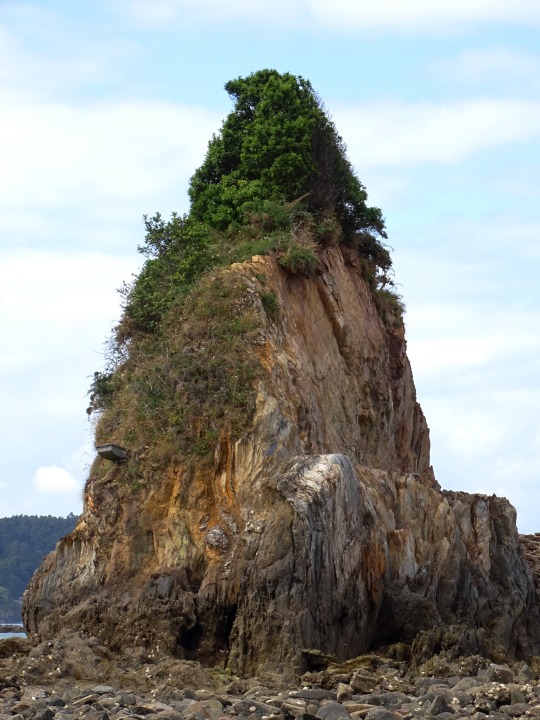


Covas Beach, Viveiro (No. 7)
Lugo is a Spanish province, one of the four that make up the autonomous community of Galicia. It limits to the north with the Cantabrian Sea, to the west with the province of La Coruña, to the southwest with that of Pontevedra, to the south with the province of Orense and to the east with the Principality of Asturias and the province of León.
Although it is the largest of the four Galician provinces, it is the third in number of inhabitants (331,327), surpassing only Orense (309,293 inhabitants according to the INEof 2018).
Its capital is Lugo and the main towns, apart from the capital, are Monforte de Lemos, Vivero, Villalba, Sarria and Foz.
The main rivers are the river Sil and the Miño, which also runs through the province of Orense and forms the boundary between the province of Pontevedra and Portugal, flowing into the Atlantic. On the Cantabrian coast it has many small rivers.
Source: Wikipedia
#Santa María Magdalena and Palomo Monument#Cantabrian Sea#sand#shell#rock formation#Os Castelos#Playa de Covas#Covas Beach#Praia de Covas#Spain#Northern Spain#España#Southern Europe#summer 2021#travel#original photography#landmark#tourist attraction#landscape#cityscape#seascape#reflection#hills#public art#Atlantic Ocean
0 notes
Photo










Covas Beach, Viveiro (No. 6)
The vast majority of people have a common language which is Galician. Some people, especially the older generation, are monolingual and only speak Galician. There are only a few people bilingual in Galician and Castilian of the little over 10,000 inhabitants. Even in the capital, the vitality of the Galician language in conversation is very strong.
The inhabitants speak several variants of Galician in the province of Lugo. They have the characteristics of being the closest to León isoglosses and therefore also the Castilian language. So they have some grammatical and phonetic signs that are mistakenly considered influences of the Castilian or Leonese languages. However, the language of Galicia in Lugo, especially in non-coastal areas, is probably the most genuine in Galicia, due to almost no historic pressure of Castilian exercised on the rural population.
Source: Wikipedia
#Santa María Magdalena and Palomo Monument#Playa de Covas#España#Covas Beach#Praia de Covas#sand#shell#waves#Os Castelos#summer 2021#Original McDonald's Museum#Southern Europe#Northern Spain#landscape#cityscape#memorial#seascape#travel#Cantabrian Sea#Atlantic Ocean#rock formation#tourist attraction#landmark
0 notes
Photo










Viveiro, Spain
The Capilla de la Misericordia or capilla de Nuestra Señora de la Misericordia is a religious building located in the city of Vivero, in the province of Lugo (Galicia, Spain), belonging to the parish of Santiago de Vivero. It is located on the outskirts of the population center, in the neighborhood to which it gives its name, Misericordia, on the other side of the Vivero estuary. It is linked to the urban center by the Bridge of Mercy, which receives the name of this chapel.
Attached to it is the Pazo de la Misericordia, which also takes the name of the chapel, and which was the head of the eldership instituted by Don Pedro de Posada y Alfeirán, grandson of the founder of the chapel, and his wife, Doña María de Pallares y Somoza, by Royal Faculty granted by Don Felipe IV in 1660.
José María Bermúdez de Castro y Pardo was born in the pazo.
From its origins the ownership of the chapel and pazo de la Misericordia remained within the descendants of the founder of the same, Don Rodrigo Alonso de Alfeirán, until in 2001 his descendants, the Bermúdez de Castro family, transmitted the ownership of both to the City Council of Vivero, who ceded the administration of the chapel to the parish of San Francisco de Vivero.
Source: Wikipedia
#Santa María Magdalena cannon#Miner's Memorial#Viveiro#Galicia#Spain#in memory of all the miners who worked in the silvarosa#Capilla del Ecce Homo#Chapel of Mercy#Capilla de la Misericordia#Pazo de la Misericordia#Santa María Magdalena and Palomo Monument#beach#low tide#new part#evening light#architecture#public art#cityscape#tourist attraction#Chicago Landmark#España#summer 2021#original photography#Southern Europe#Northern Spain
1 note
·
View note
Photo










Covas Beach, Viveiro (No. 2)
The beach of Covas is a beach of 1650 m in length, located in the municipality of Viveiro. This beach enjoys facilities and services, and high occupancy in the summer season, equipped with a promenade, calm waters, with rescue and safety equipment and access for the disabled.
In the western part of the beach there are some protruding rocks known as Os Castelos. On these rocks stands a monument dedicated to the memory of the frigate Santa María Magdalena and the brig Palomo that were shipwrecked together on a terrible storm night in 1810, causing more than 500 victims. Remains of the shipwreck adorn some corners of the city: cannons in Pernas Peón Park, next to Covas beach, and anchors in a square in the urban area, and in the Castles monument itself.
Source: Wikipedia
#Covas Beach#Playa de Covas#Cantabrian Sea#Atlantic Ocean#sand#mussel#original photography#nature#landscape#cityscape#seascape#Praia de Covas#tourist attraction#landmark#hills#blue sky#clouds#travel#vacation#summer 2020#Galicia#province of Lugo#A Mariña Occidental#Spain#Northern Spain#España#Southern Europe#wave#shell
3 notes
·
View notes
Photo










Covas Beach, Viveiro (No. 1)
The beach of Covas is a beach of 1500 m in length, located in the municipality of Vivero, in the province of Lugo (Galicia, Spain). This beach enjoys facilities and services, and high occupancy in the summer season, equipped with a promenade, calm waters, with rescue and safety equipment and access for the disabled.
In the western part of the beach there are some protruding rocks known as Os Castelos. On these rocks stands a monument dedicated to the memory of the frigate Santa María Magdalena and the brig Palomo that sank together on a night of terrible storm, the year 1810, causing more than 500 victims. When he becomes enraged and accompanied by great hangovers and disstars the beach, he reveals the remains of those ships. Wrecks adorn some corners of the city: cannons in the Pernas Peón Park, next to Covas beach, and anchors in some square in the urban area, and in the monument of Os Castelos itself.
Source: Wikipedia
#Covas Beach#Playa de Covas#Galicia#Viveiro#street lamp#vacation#province of Lugo#Cantabrian Sea#Cantabric coast#Atlantic Ocean#landmark#tourist attraction#Northern Spain#Spain#España#summer 2021#A Mariña Occidental#cityscape#landscape#nature#palm tree#seascape#architecture#ship#boat#Southern Europe
2 notes
·
View notes
Photo










National Cherish An Antique Day
Ask the older members of your family about the histories behind the antiques in your home. Clocks, dishware, jewelry and more can hold surprising stories.
Antiques all have historical value. For those who look at antiques and don’t think much of them, then this is the day to ask questions. It’s a great way to learn about the treasured stories behind the antiques.
National Cherish An Antique Day celebrates the history behind the item, the celebration of families and their stories. You can also learn about the collectors that maintain that history through preservation and upkeep.
History of National Cherish An Antique Day
While all forms of history can be preserved, antiques can provide a unique perspective of how people cherish and maintain their antiques in their own homes.
Antiques specifically refer to the preclassical and classical cultures of the ancient world. People began to collect antiques around the 16th century when English and European collectors would flourish with rarities. However, these collectors would exist among the upper-class members of the late Renaissance society. It wasn’t until the 18th century that both public and private members would begin to collect antiques.
This began to happen alongside the development of art and the science of archaeology. During the 18th century, many movements to preserve authentic antiques. These antiques included books, possessions, and mementos left by family members. They became quite popular among people who would become collectors.
From there, antiques not only became valued for their history but also their connection to families. National Cherish An Antique Day acknowledges people who collect antiques from all over the world.
It gives people the chance to explore the world of antiques through museums and antique shops. It also allows those with antiques to look into the history of their families and appreciate the stories behind their lives.
It’s also a day to thank those who aim at repairing antiques and bringing life back into them. So take the time to clean your antiques, ask your relatives what they are, and appreciate the antiques of your home on this day.
How to Celebrate National Cherish An Antique Day
Celebrate National Cherish An Antique Day by taking the time to learn the story of the antiques throughout your home.
Ask your mother, grandma, father, or grandpa about why they hold on to the antiques throughout your home. If you have an antique in your home, polish it up, repair it, and maintain its value.
Take a trip to your local antique shop and look around for beautiful furnishing to decorate your home. Spend some time with an antique collector and learn about the appreciation and care that goes into the craftsmanship of antique collecting.
Source
#Molino de Viento y Centro de Interpretación#ship wreck#Viveiro#España#National Cherish An Antique Day#NationalCherishAnAntiqueDay#9 April#travel#original#old stuff#Santa María Magdalena cannon#anchor#Santa María Magdalena and Palomo Monument#La Rioja#Carboneras#Sweden#Falun Mine#summer 2021#2020#Öland#wind mill#Gettysburg Battlefield Historic District#Turnbull Wine Cellars
3 notes
·
View notes